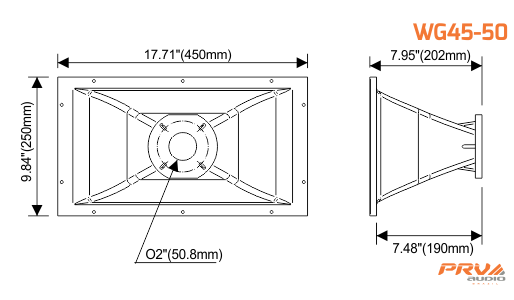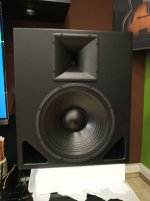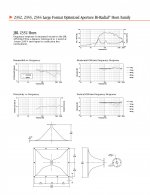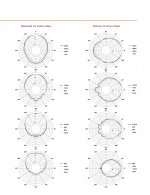There's a lot going on there, I wasn't trying to write the book on driver design for midrange vs. woofers and subs
Not necessarily having much impact on midrange viability- case in point, the shorting sleeve solution accomplishes both improvement to thermal performance as well as better midrange viability.
I'm on the train of thought of my design and therefore intensely biased... it is not easy to damp a extremely large membrane on a powerfull motor where there is no place for a shorting sleeve, but IMHO it is more a technical design choice than a vital element.
I'm on the train of thought of my design and therefore intensely biased... it is not easy to damp a extremely large membrane on a powerfull motor where there is no place for a shorting sleeve, but IMHO it is more a technical design choice than a vital element.
I think you took the right train (of thought), silversprout
I think you took the right train (of thought), silversprout
Your remark opens the field of philosophy, so i will do what i can and stay far away of any dogmatism because there is no good desing
Are you still building/experimenting? We had some exchange of thoughts last year, if I remember correctly. You showed a paper mache horn ao.
For your intimite listening space, I would opt for an efficient 12 or 15" with horn or AMT from 60-80Hz and up, complemented with 2 smaller (active) subs.
You might want to look for some older B&C's like the 12 PE 32, 12 PH 32, 12 PL 32 (or equivalent drivers from other brands) which are perfect for such a setup.
At night you could switch off the subs, in order to listen without disturbing the neighbours
For your intimite listening space, I would opt for an efficient 12 or 15" with horn or AMT from 60-80Hz and up, complemented with 2 smaller (active) subs.
You might want to look for some older B&C's like the 12 PE 32, 12 PH 32, 12 PL 32 (or equivalent drivers from other brands) which are perfect for such a setup.
At night you could switch off the subs, in order to listen without disturbing the neighbours
I can't believe the only source of horns is Poland...like, seriously?
I did find this 2" to 1.5" or 2"Throat Horn Flare Bolt On 10" x 18" For Assorted Bolt On Drivers | eBay
a version of another horn recommended in this thread that has some kind of 1.5-2" adapter.
I did find this 2" to 1.5" or 2"Throat Horn Flare Bolt On 10" x 18" For Assorted Bolt On Drivers | eBay
a version of another horn recommended in this thread that has some kind of 1.5-2" adapter.
That's the horn also known as the ZXPC 10x18, available at this store for 10 bucks less.
They also sell the 11x17, a Selenium/JBL clone with somewhat narrower dispersion (contrary to the specified 90x40), but pretty good nonetheless.
The 10x18 is also sold by PRV Audio and available at PE.

They also sell the 11x17, a Selenium/JBL clone with somewhat narrower dispersion (contrary to the specified 90x40), but pretty good nonetheless.
The 10x18 is also sold by PRV Audio and available at PE.

An externally hosted image should be here but it was not working when we last tested it.
The 2352 is used for this modular Cinema system:
An externally hosted image should be here but it was not working when we last tested it.
An externally hosted image should be here but it was not working when we last tested it.
It was the first part of the complete loudspeaker driver unit conception, commercial PA coaxials are too small for my application.Are you still building/experimenting? We had some exchange of thoughts last year, if I remember correctly. You showed a paper mache horn ao.
I tried 6-8-10-12-15-18 in woofers in various enclosures and experienced terrible room modes each time.For your intimite listening space, I would opt for an efficient 12 or 15" with horn or AMT from 60-80Hz and up
I removed all the subs in my room, my custom 25in IB coax woofers can go to 30Hz (+3dB) at one meter with a higher level of détail in the low medium (thanks to the direct field)complemented with 2 smaller (active) subs.
Too small and already tested in closed/Vented/aperiodic/semi-open boxes, room modes each time.You might want to look for some older B&C's like the 12 PE 32, 12 PH 32, 12 PL 32 (or equivalent drivers from other brands) which are perfect for such a setup.
The direct field immersion have reduced my listening level by 7dB(Z), my comfort zone was around 80dB (37NF) and 73dB (37NF) now...At night you could switch off the subs, in order to listen without disturbing the neighbours
Jbl 2384 is on sale, wouldn't that be a step up from the 2352? Diffraction slots are or are not the devil? I thought for cinema no problem but for music, not so good?
I've found some info in the past on the 2384, will have to start digging to find it again. Anyone got polars on this model?
I've found some info in the past on the 2384, will have to start digging to find it again. Anyone got polars on this model?
So diffraction slots are not a deal breaker? The jbl 2834 and m2 horn any good?
A quote from the lansingheritage forum:
"I have used nearly all 2" horns jbl has made in various projects and while the 2382 will give you the wide dispersion, the 235X series of 1.5" horns with the "throatless" drivers will give you much better results."
The late Zilch:
"I have run them (2352s) with 2435HPL and 2452H-SL and find them to be "transcendent."
I think the bad reputation of diffraction horns has a lot to do with the quality of the drivers that were used, as well as the implementation.
It was Bjorn Omholt who stated earlier he prefers the sound of his prototype diffraction horn to the the K402.
I also think that a short diffraction slot, like the one in the 2352 (and Bjorn's horns), makes a big difference compared to oldskool long slots that were used in Mantarays and the like.
Compared to the 2380, the 2352 is a more advanced design. The slot is relatively short and the mouth much bigger.
The Strauss MF-2 has the 2380 (with a Sony compression driver from the 1990s) and according to those who've heard the MF-2s,
it's one of the best monitors on the market.
Some data from the 2352 specsheet:
Attachments
Last edited:
It looks like the M2 horn is the about the best I can do here in America, though it isn't a tractrix, It does have the appropriate size to transition to a 15" woofer and lacks diffraction slotting in the traditional sense.
The people at autotech horns haven't responded beyond acknowledging how expensive it might be to ship to america, guess they don't want my money.
We posted at the same time, So M2 vs 2352 it is...
The people at autotech horns haven't responded beyond acknowledging how expensive it might be to ship to america, guess they don't want my money.
We posted at the same time, So M2 vs 2352 it is...
Last edited:
The M2 is a very nice waveguide, but I doubt it will outperform the (>20 years old) RCF H100 by a margin.
For a lower XO you'll need a slightly deeper horn. In this respect, the M2 WG isn't a big horn, the size is largely determined by the 'butts'.
Today, horn science is more about refinement instead of true innovation.
In spite of all the R&D tools available, you'll find modern horns and waveguides are often variations on a theme.
For a lower XO you'll need a slightly deeper horn. In this respect, the M2 WG isn't a big horn, the size is largely determined by the 'butts'.
Today, horn science is more about refinement instead of true innovation.
In spite of all the R&D tools available, you'll find modern horns and waveguides are often variations on a theme.
Last edited:
- Home
- Loudspeakers
- Multi-Way
- Is it possible to cover the whole spectrum, high SPL, low distortion with a 2-way?



